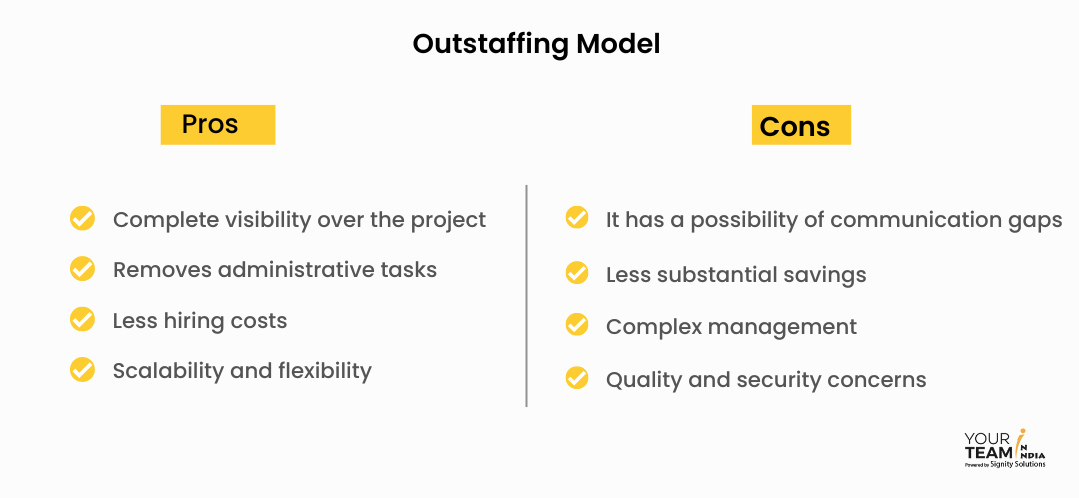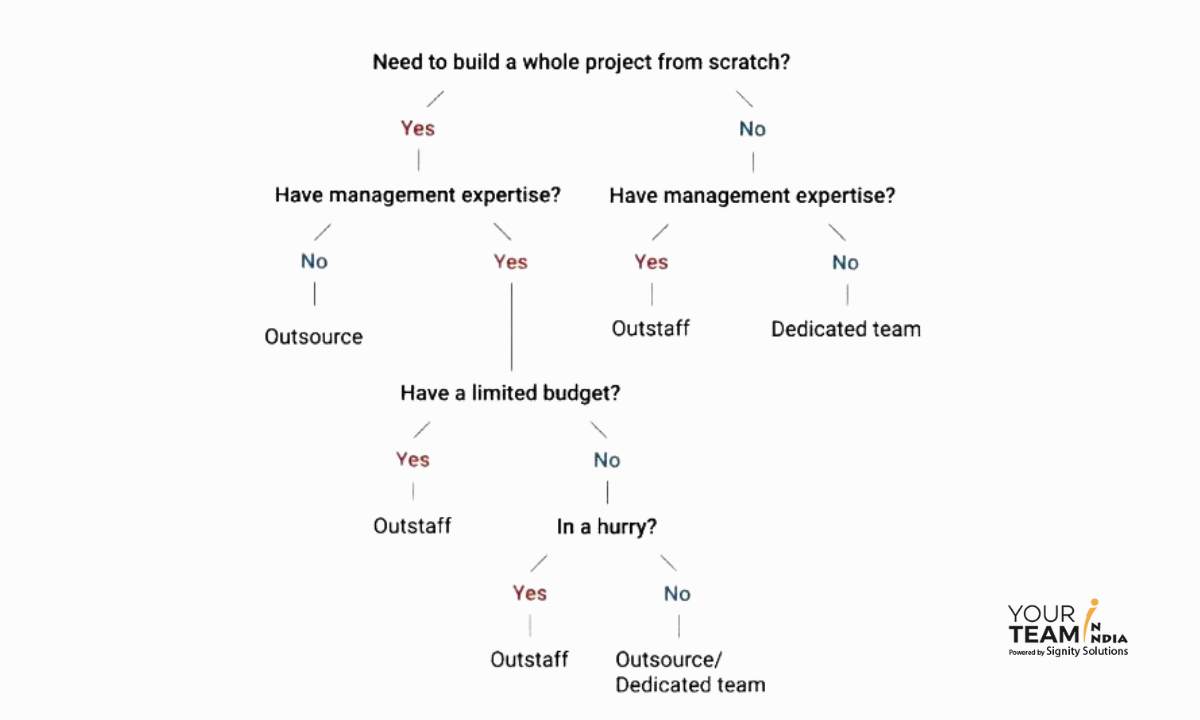Quick Summary: Outsourcing and outstaffing are two popular offshore development models that are often confused with one another. However, they are not the same. This blog aims to provide you with a better understanding of the differences between the two models and help you make an informed decision.
Introduction
Businesses of all sizes are always looking for efficient ways to grow. With the expansion of remote hiring options, organizations often face a difficult choice: outsourcing vs outstaffing.
Which option should you choose for your project requirements?
But before that, do you know?
92% of G2000 companies outsource time-consuming development tasks to focus on core objectives.
Both outsourcing and outstaffing involve cost reduction, task delegation, and access to global expertise. However, they also have significant differences that can help take your business to the next level.
“According to the Grand View Research Report, the global cost of outsourcing and outstaffing is expected to reach USD 936.6 billion by 2027.”
Key Takeaways
- Outsourcing and outstaffing can reduce operational costs by assigning project tasks to external providers, saving on labor costs, and eliminating in-house overheads.
- Both models allow businesses to access a diverse pool of global talent that fits their budget and required expertise.
- The two models differ in terms of the engagement structure and the level of control the client retains over the team.
Certainly, a huge number! But how to take the most benefit out of both models?
Well, it is by selecting the correct model based on the project requirements. This blog will walk you through the comprehensive insights on both models to help you make an informed decision. So, let’s dig in!
Outsourcing Model: What is it?
The outsourcing model refers to a process where companies contract an external IT company to take full responsibility for their entire project. In this model, the external company manages the team members and handles administrative tasks and project deliverables.
An outsourcing provider typically follows a project-based business model, wherein the client delegates the entire project to the outsourcing company. As a result, the client rarely has direct access to the development team, and the team members may be working on several projects at the same time.
The outsourcing model is often utilized for entire projects or ongoing tasks that can be handled independently by the external provider.
Well Suited for:
It is well suited for companies and startups with short-term and precise requirements.
Outstaffing Models: What is it?
The Outstaffing model is a process of staff augmentation where businesses hire IT professionals from outsourcing companies to enhance the skills of their existing teams. In this type of model, the outsourced teams continue to work remotely but are fully managed by the company that hired the resources.
Outstaffing is when a company hires professionals who already work for another company. The client company hires these pros to work on a specific project, but their main company will still employ them.
So, the employer will handle things like payroll and HR activities, while the outstaffed team will keep working on projects for other companies. The client company that hired the team will be responsible for managing the project, giving directions, and paying for the completed work.
Well suited for:
Companies or startups are seeking developers with specific skills.
Outsourcing vs. Outstaffing Model: What is the difference?
The models are somewhat similar, but the main difference between both models is that outsourcing is about passing all of the project responsibilities to the third-party agency, while outstaffing is about hiring experts from other firms to work on the project under the control of the hiring client. The primary distinguishing factors between both models are:
|
Parameters |
Outsourcing |
Outstaffing |
|
Purpose |
Outsourcing services is to develop or redevelop a quality product from scratch. |
Outstaffing services are done to find a developer with specific expertise for a project. |
|
Management |
An outsourced development agency manages the outsourcing team. |
The team in outstaffing is managed by the client or the hiring company. |
|
Time |
Outsourcing takes time to set the process as the company needs to evaluate the project and communicate the specifications clearly. |
Outstaffing provides a faster development start as an outsourcing agency already hires a developer. |
|
Budget |
Outsourcing services generally cost more than out-staffing services while providing cost-effective access to expertise as compared to in-house development. |
Outstaffing services are generally a budget-friendly option. |
|
Flexibility |
Limited flexibility in scaling resources up or down quickly. |
Greater flexibility in scaling resources based on project demands or changing business needs. |
|
Communication |
Direct communication with the outsourcing partner. |
Direct communication with the outstaffed professionals, integrated into the client's team. |
|
Common Uses |
Frequently used for specific tasks or functions not core to the business. |
Commonly used for augmenting the in-house team for specific projects or tasks. |
|
Control |
Less control over the day-to-day activities of the outsourced tasks. |
More control over the work of outstaffed professionals as they integrate into the in-house team. |
Pros and Cons of Outsourcing
The outsourcing model is a great way for businesses to be flexible when it comes to fulfilling their software development needs. By outsourcing, businesses can access a global pool of talent and delegate their entire software development requirements to third-party IT teams who can manage the project progress and produce desired outcomes. However, the outsourcing model brings a wide range of advantages and a few cons along. Let's take a look at them below:
.png?width=1079&height=498&name=Pros%20and%20Cons%20of%20the%20Outsourcing%20Model%20(2).png)
Pros of Outsourcing
1. Cost Savings
Outsourcing tasks to countries with lower labor costs can significantly reduce expenses, including wages, benefits, and infrastructure costs.
2. Access to Specialized Skills
It enables access to specialized skills and proficiency that may not be available in-house, allowing companies to benefit from the knowledge and experience of external professionals.
3. Time Savings
Outsourcing tasks can save time by delegating repetitive or time-consuming functions to external vendors, enabling companies to focus on strategic initiatives and business growth.
4. Focus on Core Activities
Outsourcing non-core functions allows companies to concentrate on their core competencies, leading to improved efficiency and productivity.
5. Flexibility and Scalability
It provides flexibility in staffing levels, allowing companies to scale their operations based on demand without the constraints of permanent employees.
6. Risk Mitigation
Outsourcing specific functions can help mitigate risks associated with fluctuations in demand, technological advancements, or regulatory changes, as vendors often assume responsibility for these aspects.
Cons of Outsourcing
1. Loss of control
Giving up some control over specific business functions through outsourcing can raise questions about security, quality, and adherence to corporate standards.
2. Communication challenges
Communication difficulties arising from language barriers, cultural disparities, and time zone differences may affect the efficiency and productivity of businesses communicating with their offshore outsourcing partners.
3. Dependency on vendors
Over-reliance on outsourcing vendors for essential tasks can put businesses at risk if the vendor underperforms or experiences operational disruptions.
4. Confidentiality risks
Concerns regarding data security breaches and confidentiality arise when sharing confidential business information with outsourcing partners, especially in sectors with strict regulatory requirements.
Recommended Read: How to Evaluate IT Outsourcing Cost in 2024?
Pros and Cons of the Outstaffing Model
Outstaffing is a hiring model that allows businesses to bring in dedicated developers who work as part of their internal team. With this approach, companies have full control over project coordination, task assignment, and direction, leading to the production of desired outcomes. However, it's important to note that this model has its own pros and cons. Let's take a closer look at them.

Pros of Outstaffing
1. More access and control of the team
Outstaffing allows businesses to have complete control over the daily operations and projects, enabling them to manage the project process more accurately.
2. Cost-effective
Since the businesses do a lot of hard lifting for the management, the hours spent managing the responsibilities of an out-staffed team are lower. Outstaffing eradicates the hours spent on project management.
3. Hiring flexibility
Outstaffing is one of the most flexible hiring models that provides easy adjustment to schedules, sets direction and involvement levels, and delegates particular projects and tasks.
Cons of the Outstaffing Model
1. Project Responsibility
While having complete control over the projects assigned to the outstaffing team, the managing of teams brings a lot of responsibilities along. Therefore, the responsibility of managing an outstaffed team, aligning them with your goals, and making them deliver the requisites on time would be done at the client's end. That is certainly intricate to handle.
2. Communication issues
Since the out-staffed team is not working in-house, having a clear and continuous conversation with them would certainly be challenging.
Common misconceptions about outsourcing and outstaffing
As companies find more cost-effective solutions, misconceptions about software outsourcing and outstaffing persist. Here are some common myths about both models:
Outsourcing and outstaffing are the same
Many businesses wrongly assume that outsourcing and outstaffing models, which fall under the umbrella of offshoring models, are the same. However, in reality, they are quite different. One significant difference between the two is that, in outsourcing, the vendor side handles project management and team management, whereas in outstaffing, the client is responsible for managing the entire team.
Offshore organizations manage teams
Well, if you also think alike, lemme tell you that it's not true. The clients are responsible for tracking all the activities assigned to the team, managing the progress, and communicating effectively with the developer or a dedicated offshore team.
No actual communication is required
It is a common misconception that hiring an offshore team means there is no need to communicate with them. However, the truth is the opposite. Good communication is crucial to avoid any confusion and ensure that everyone is on the same page.
Therefore, it is essential to maintain effective and clear communication with remote teams or those who are managing the project independently. Remember, effective communication is like a bridge between clarity and confusion.
“WHEN” and “WHICH” models should you choose?
When making the best choice among the two models, several factors are required to be taken into consideration.

1. Project scope
The project scope is a crucial factor that needs to be considered to address the problem type effectively. It is essential to communicate the project scope clearly while sharing the requirements and ultimate goal. The list of tasks makes it evident that it is not a single-person job, and software outsourcing could be a feasible choice.
However, if expert support is needed for the in-house team, outstaffing can be counted on. Therefore, it is essential to have a complete understanding of in-house vs. outsourcing to make an informed decision.
2. Type of problem
The type of offshore development model highly depends upon the project requirements. If the in-house team is incapable of problem-solving and requires specific expertise to handle the project requirements, outstaffing is a great option. Otherwise, outsourcing is feasible if the project requires dedicated expertise from scratch.
3. Required technical expertise
Obtaining the necessary technical skills is one of the most important aspects. Therefore, when outsourcing software development, you should first evaluate the expertise you need and create tasks accordingly. It is also crucial to examine the developer's proficiency in various software development areas to make an informed decision.
4. Team management
When talking about team management, it is imperative to have a clear understanding of whether you can take the responsibility of monitoring and managing the project along with the team or whether an intermediate project manager's dedication would work for you. A software development outsourcing project can easily be handled with the help of a project manager, while in outstaffing, the client needs to manage the augmented team.
5. Budget and costs
When deciding to offshore, cost is a crucial factor to consider. This will help you determine which model is best suited for your project requirements.
Outstaffing involves adding expertise to your existing team and, therefore, incurs fewer costs. On the other hand, outsourcing involves hiring a dedicated team, which can be more expensive compared to outstaffing. Hence, your budget for a specific project is an important deciding factor.
It is worth noting that the entire development cost control also depends on the IT outsourcing partner you choose. Therefore, it is crucial to select a reliable offshore software development partner.
Outsourcing vs Outstaffing: Which model to choose?
When an organization is looking for a software development company that provides the best offshore development services, there are two factors they need to consider - the efficiency of the end outcomes and the price of the service.
Both outsourcing and outstaffing offer reliable and rapid results that consider your business objectives. However, whether you should opt for software development outsourcing or IT outstaffing depends on your business needs and requirements.
For instance, if your project analysis is ready, it would be best to outsource it to an expert team.
On the other hand, if you need to monitor the performance and efficiency of your remote workforce and take more responsibility, then IT outstaffing is the perfect approach for you.
Bottomline
When considering outstaffing vs outsourcing, businesses must accurately analyze the benefits and drawbacks of each model. It is crucial to do so in the context of their particular requirements, organizational culture, and the nature of the projects involved.
Businesses across the globe have entrusted Your Team In India with providing top-quality IT outsourcing, task delegation, and team augmentation services. Our team of proficient experts offers a range of services, including software project and website development, IT consulting, and legacy system upgrades, among others.
We pride ourselves on our vast experience in both outsourcing and outstaffing domains and strive to help our partners find the most suitable solution for their project requirements and budgetary constraints. Our unparalleled expertise and commitment to excellence have made us a reliable offshore development partner for businesses seeking to streamline their IT operations and optimize their performance.
Looking to outsource your next project or just augment the existing in-house team?
Complete all the missing elements of your development team and manage all the tasks you assign them.
Frequently Asked Questions
What is the difference between outsourcing and outstaffing?
Outsourcing and outstaffing are two models of offshore web development. Outsourcing is a model of offshore web development where a company hires another company, typically a software outsourcing company, to handle the entire project scope, from planning to development and testing. On the other hand, outstaffing is a type of offshore web development where a client hires an external software outsourcing company to perform specific development tasks.
What is outstaffing?
Outstaffing, also referred to as staff augmentation, is a business practice that entails the engagement of external professionals or teams through a service provider to work as an extension of a client's in-house team on a temporary or project-based basis. The primary objective of outstaffing is to augment the client's existing workforce with skilled and experienced professionals without the need for permanent employment.
What is outsourcing?
Outsourcing refers to hiring external vendors or third-party service providers to perform specific tasks, projects, or functions as agreed upon.
Can outsourcing and outstaffing be used together?
Yes, companies can use a combination of outsourcing and outstaffing based on their specific needs and requirements for different projects or functions.
How do companies choose between outsourcing and outstaffing?
When choosing between outsourcing and outstaffing, it is crucial to consider several factors: the project, level of control, expertise required, budget constraints, and long-term goals.
These factors help in deciding which model could be the best one for a company's specific requirements.
Who manages the resources in outsourcing and outstaffing?
In outsourcing, the external vendor manages resources and delivers services independently. In outstaffing, the client retains control and integrates resources into their team.







